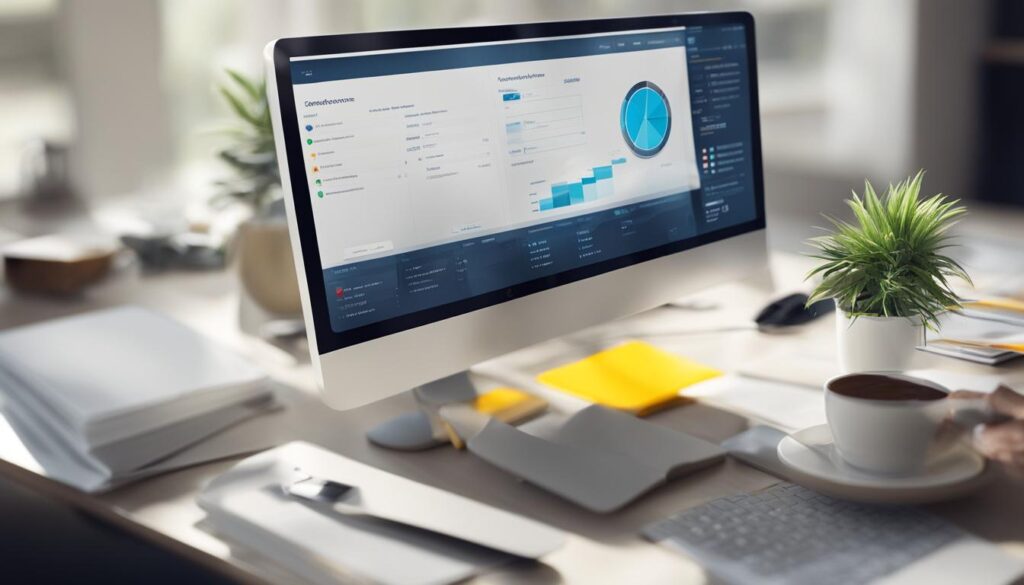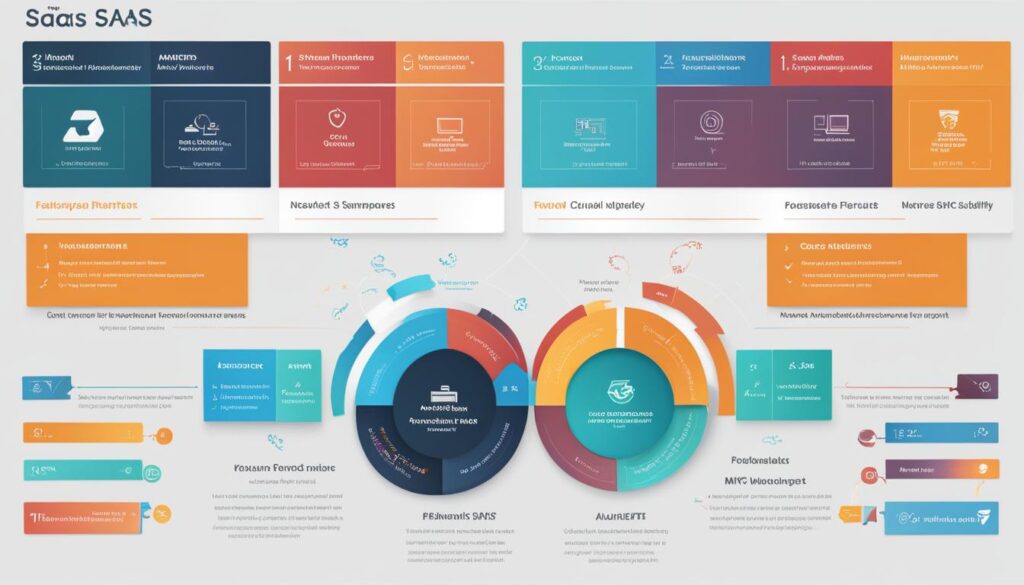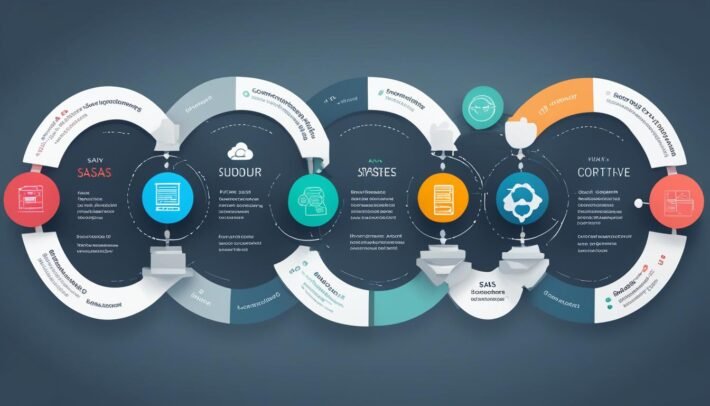Building a Successful MVP for Your SAAS Startup

If you’re in the process of launching a software as a service (SAAS) startup, you’ve probably heard the term MVP development. MVP stands for minimum viable product, a concept that has gained significant traction in recent years.
The benefits of developing an MVP for your SAAS startup are significant. It allows you to test the waters before committing significant resources and time. With an MVP, you can validate market demand, receive feedback from early adopters, and optimize resource allocation. This way, you can get your product into the hands of users quickly and discover if there’s genuine interest, helping you make informed decisions about whether to move forward with your plan.
In this article, we’ll take a deep dive into developing an MVP for your SAAS startup. We’ll cover everything from defining and designing your MVP to prototyping, developing, testing, and launching it. We’ll also explore strategies for scaling your SAAS startup from your MVP and staying competitive in the SAAS market.
Key Takeaways
- Developing an MVP is crucial for launching a successful SAAS startup.
- MVP is a fully functional version of your product with essential features, focusing on gathering user feedback.
- An MVP minimizes risk and optimizes resource allocation, allowing you to validate market demand and identify areas for improvement.
- The MVP development process involves planning, defining features, prototyping, developing, testing, and launching a product.
- Tracking user engagement and feedback metrics can help measure the success of your startup and improve the user experience.
What is an MVP?
An MVP stands for Minimum Viable Product. It is a product development strategy that involves creating a product with just enough features to satisfy early users and gather feedback for future development.
An MVP is not a fully developed product and generally has limited features and functionality. Its goal is to test the product hypothesis and determine whether there is a market demand for the product before investing significant resources in further development.
The key characteristics of an MVP include:
- Focus on essential features: An MVP includes only the most critical features necessary to meet the needs of the target audience and validate the product idea.
- Goal of gathering user feedback: The primary objective of an MVP is to collect user feedback and data to refine and improve the product for future development.
- Quick and cost-effective development: The development of an MVP is typically faster and less expensive than a fully developed product, allowing for more rapid testing and iteration.
By developing an MVP, SAAS startups can mitigate risks, validate market demand, and optimize resource allocation for future development. The next section will explore why MVP development is essential for SAAS startups.
Why is MVP Development important for SAAS startups?
Developing a minimum viable product (MVP) is a crucial step for any SAAS startup. An MVP is a stripped-down version of your product that focuses on essential features while leaving out non-critical components. This approach lets you move fast, test concepts quickly, and get user feedback.
But why is MVP development so important? Let’s explore:
| MVP Development Benefit | Description |
|---|---|
| Risk Mitigation | An MVP helps minimize risks, both financial and technical. By launching a lean product, you can gather user feedback and validate your concept before you invest significant resources in development. |
| Market Demand Validation | Creating an MVP helps you validate market demand for your product. It helps you test your assumptions, see if there is actual interest in your product and whether users are willing to pay for it. |
| Resource Allocation Optimization | Developing an MVP forces you to prioritize features and functionalities that drive real value to users while allowing for a faster time-to-market. It allows you to allocate resources more efficiently. |
These benefits highlight just how valuable MVP development can be for your SAAS startup. By focusing on essential features, gathering user feedback, and validating your concept, you can increase your chances of success in a highly competitive market.

Planning Your MVP Development Process
Before starting the development of your MVP for your SAAS startup, it is crucial to have a clear plan in place. MVP development requires careful consideration of goals, target users, and feature prioritization to ensure a successful launch.
Defining Clear Goals
When planning your MVP development process, it is essential to define clear, specific goals. This should include identifying the purpose of the product, what key issues it addresses, and how it will solve them. By doing so, you can ensure that you are creating a product that meets the needs of your users.
Identifying Target Users
Understanding your target audience is critical to the development of a successful MVP. You need to have a clear understanding of who they are, their pain points, and what they need to solve their problems. By doing so, you can create a product that meets their needs and speaks directly to them.
Prioritizing Features
Once you have defined your goals and target users, it’s crucial to prioritize the features you will include in your MVP. Identify what features are absolutely necessary for the product to function and address the critical issues your users face. Remember, the focus of SAAS MVP development is to develop a product with essential features that appeal to early adopters. Avoid including features that can be added in the future, as they will only delay the launch and slow down the MVP development process.
Creating a Comprehensive MVP Development Plan
Developing your MVP involves more than just coding. It’s essential to create a comprehensive MVP development plan that includes all of the steps required for a successful product launch. This includes identifying technologies, creating a project timeline, and allocating resources. By doing so, you can ensure that your MVP development process runs smoothly and that you are on track to launch your product as planned.
Defining Your SAAS MVP Features
Defining the features of your SAAS MVP is a critical step in the MVP development process. Here are some strategies to help you identify the core functionalities that will align with your target audience’s needs:
- Conduct market research: Gather insights from your target audience to understand their pain points, needs, and preferences. This information will help you determine which features are essential.
- Consider user experience: Create user personas and map out user journeys to determine which features are necessary for a smooth, intuitive user experience.
- Prioritize features: Identify the features that are critical to the success of your SAAS MVP and prioritize them based on their impact on user experience and your business goals.
Remember, an SAAS MVP should focus on providing essential features to meet the needs of early adopters. Avoid the temptation to include too many features, which can slow down development and create a bloated product that misses the mark.

“Your MVP should have just enough features to delight early adopters and validate your product idea. Use customer feedback to refine your features and prioritize new ones as you scale.” – Jane Wang, CEO of SAAS startup, Orkiv
Prototyping Your SAAS MVP
In MVP development, prototyping plays a critical role in ensuring that the product aligns with user needs and expectations. Prototyping refers to the process of creating a working model of your product idea to gather user feedback and test its viability before investing resources in full-scale development.
There are various prototyping techniques and tools available that can help you quickly create and test your SAAS MVP:
- Wireframes: low-fidelity prototypes that outline the product’s basic structure and functionality
- Mockups: high-fidelity prototypes that include graphic elements and visual design to demonstrate the product’s look and feel
- Interactive prototypes: clickable models that allow users to interact with the MVP’s key features and functionalities
Using these prototyping techniques can help you gather user feedback early in the MVP development process, enabling you to iterate and refine your product idea based on user needs and preferences.
“Prototyping allows us to test and refine our product idea in the early stages of MVP development, saving valuable time and resources in the long run.”
Developing Your SAAS MVP
Once you’ve identified your MVP features, it’s time to start the actual development process. This is where you can start turning your vision into a tangible product. The key to success during this phase is to work smarter, not harder, by implementing agile development methodologies, which enables you to make iterative changes faster and react to user feedback more effectively. Using existing frameworks and libraries can also considerably speed up the process, saving valuable time and resources.
In addition, it’s important to maintain a focus on the MVP’s core functionalities to ensure your users can experience the product as early as possible. This provides a unique opportunity to gather data and measure user feedback while building essential features. Regular user testing and feature prioritization throughout the development cycle can help to keep the product’s development aligned with what your users actually need. By building an MVP that prioritizes users, you lend yourself to not only steady growth but opens you up for opportunities for other features to be added and developed over time.

When it comes to launching your MVP, it may be tempting to wait until everything is “perfect.” However, this can be counterproductive, as it can lead to wasted time and resources. Instead, focus on getting a “good enough” product in the hands of your early adopters, where you can continue to iterate and grow. This can be a game-changer in providing a fast product to market, leading to early user feedback and insights that can only scratch the surface of what is possible for your product.
Testing and Iterating Your SAAS MVP
After you have prototyped your SAAS MVP, it’s time for rigorous testing and continuous iteration to ensure your product satisfies user needs and stays competitive in the market.
There are various testing methods you can use, such as alpha and beta testing, A/B testing, usability testing, and more. Alpha testing is done within your development team and can help you eliminate bugs and issues before releasing the product to beta testers. Beta testing involves releasing the product to a small group of external users who can provide feedback on its usability and functionality.
A/B testing is a great way to gather data on different product features, allowing you to compare user engagement and conversion rates for each option. Usability testing helps you gather insights on how users interact with your product, identify areas for improvement, and validate user feedback.
To gather and analyze user feedback, you can use different tools such as surveys, questionnaires, and feedback forms. It’s important to define clear metrics for success and establish a feedback loop that allows you to take action based on the suggestions and complaints you receive.
Tip: Don’t be afraid to pivot and make changes based on user feedback. Continuous iteration is key to delivering a successful SAAS MVP.
| Testing Method | Objective |
|---|---|
| Alpha Testing | Eliminate bugs and issues before release |
| Beta Testing | Gather external user feedback on usability and functionality |
| A/B Testing | Compare user engagement and conversion rates for different product features |
| Usability Testing | Gather insights on how users interact with the product and validate user feedback |
Gathering and Analyzing User Feedback
Once you have received user feedback, it’s important to analyze it and take action accordingly. Use the following metrics to measure the success of your SAAS MVP:
- User engagement
- Conversion rates
Note: It’s crucial to prioritize feedback based on user needs and interests. Use it to refine your product and enhance the user experience to ensure long-term success.
Launching Your SAAS MVP
Launching your SAAS MVP is a crucial step in the product development process. To ensure a successful launch, you need to create a compelling value proposition that clearly communicates the benefits of your product to potential customers. This involves identifying your target audience and addressing their pain points to demonstrate how your SAAS MVP can solve their problems.
Another key to launching effectively is implementing a well-planned marketing strategy. This can include using social media, SEO, and paid advertising to drive traffic to your product. It’s essential to test different channels and tactics to determine what works best for your SAAS MVP.
Finally, attracting early adopters is crucial for building momentum and gaining traction. Creating a referral program or offering a free trial can be an effective way to draw in early adopters and generate buzz around your SAAS MVP. By carefully planning your launch and using data-driven strategies, you can position your SAAS MVP for success in a competitive market.
Metrics to Measure MVP Success
After launching your SAAS MVP, it’s crucial to measure its success to refine and improve your product. Here are the key metrics that you should track:
User Engagement
Measuring user engagement is crucial in evaluating how well your SAAS MVP resonates with your target audience. You can track user engagement by analyzing metrics such as time spent on your platform, number of sessions per user, and the frequency of logins and usage.
Conversion Rates
Conversion rates allow you to determine how effectively your SAAS MVP converts users into paying customers. You can track conversion rates by measuring sign-ups, subscription rates, and revenue. By comparing conversion rates to industry benchmarks, you can gauge your MVP’s performance better and adjust your strategy accordingly.
Customer Feedback
Customer feedback is critical in refining and improving your SAAS MVP. Collecting and analyzing feedback through surveys, user testing, and monitoring reviews helps you identify areas for improvement and create a more compelling product. Additionally, early adopters’ feedback can help you attract and retain new customers.
Tip: Consider setting up a user feedback portal or community to make it easier for your early adopters to provide feedback and communicate with your team.
Scaling Your SAAS Startup from MVP
Scaling your SAAS startup after successfully launching your MVP is crucial for long-term growth. Expanding your feature set, optimizing for growth, and attracting more customers are three strategies that can help take your business to the next level.
Expanding Your Feature Set
In order to remain competitive in the SAAS market, it’s essential to continue adding new features to your product. However, it’s important to prioritize which features to develop based on customer feedback and market demand. By expanding your feature set strategically, you can attract new customers and retain existing ones.
Optimizing for Growth
Optimizing your business for growth involves setting ambitious goals, tracking relevant metrics, and experimenting with new marketing campaigns and business models. By constantly testing and refining your strategies, you can identify what works best for your business and scale more efficiently.
Attracting More Customers
Attracting new customers is a key component of scaling any SAAS startup. To do so, it’s important to invest in effective marketing campaigns, optimize your website for conversions, and provide exceptional customer support. Maintaining a strong online presence and utilizing social media channels can also help increase your brand awareness and attract more customers.
“Scaling a SAAS startup requires careful planning, continuous innovation, and a focus on providing value to your customers. By following these strategies, you can take your MVP from a promising concept to a thriving, successful business.”
Leveraging User Feedback for SAAS Startup Growth
User feedback is crucial for the growth and success of any SAAS startup. Incorporating user feedback in product development ensures that your product meets the needs of your target audience, resulting in increased customer satisfaction and retention. In this section, we will discuss how to gather, analyze, and prioritize user feedback to drive SAAS startup growth.
Gathering User Feedback
The first step in leveraging user feedback for SAAS startup growth is to gather feedback from your users. This can be accomplished through various channels, including surveys, online reviews, and customer service interactions. It’s crucial to make the feedback process as easy as possible for users to encourage participation.
“Our customer support team plays a vital role in gathering user feedback. They interact directly with our customers and are trained to recognize patterns and trends in user feedback. We also send out surveys and analyze online reviews to gain additional insights.” – John Smith, CEO of SAAS Startup Co.
Analyzing User Feedback
Once you have gathered user feedback, the next step is to analyze it to gain insights into customer needs, pain points, and areas for improvement. Categorize feedback into common themes, and identify which issues affect the most users. This information will help you prioritize product improvements and new feature development.
| Feedback Category | # of Users Affected | Priority Level |
|---|---|---|
| Easy to Use Interface | 100 | High |
| More Pricing Plan Options | 75 | Medium |
| Better Integration with Other Software | 50 | Low |
Prioritizing User Feedback
After analyzing user feedback, it’s essential to prioritize it based on the severity of the issue, the number of users affected, and the potential impact on customer satisfaction and retention. Use the prioritized feedback to inform product development, and communicate progress to users to improve transparency and trust.
“We created a product roadmap based on the feedback priorities identified by our users. We also make sure to communicate progress through regular updates and feature releases, so users know that their feedback is taken seriously and that we are working to make improvements that benefit them.” – Sarah Johnson, Product Manager of SAAS Startup Co.
By leveraging user feedback, SAAS startups can develop and improve their products to meet the evolving needs of their customers, resulting in increased customer satisfaction, retention, and growth.
Staying Competitive in the SAAS Market
In the highly competitive SAAS market, staying ahead of the curve is essential for long-term success. As the industry continues to evolve at a rapid pace, businesses must remain agile and adaptable to shifting trends and customer needs.
One key strategy for maintaining a competitive edge is through continuous innovation. By regularly introducing new features and functionalities, businesses can keep their customers engaged and attract new users.
Another crucial aspect of staying competitive in the SAAS market is by monitoring competitors closely. By analyzing competitors’ strengths and weaknesses, businesses can identify opportunities for differentiation and improvement in their own offerings.
Lastly, staying updated on industry trends is critical for staying ahead of the curve. By keeping tabs on emerging technologies and changing market dynamics, businesses can proactively adapt their strategies and offerings to align with market demand.
Conclusion
Building a successful MVP is critical for launching a SAAS startup effectively and attracting early adopters. By defining a minimum viable product, you can focus on essential features and gather user feedback to validate market demand.
MVP development also helps mitigate risks, optimize resource allocation, and refine your product before scaling. By leveraging user feedback, continuously iterating, and staying updated on industry trends, you can maintain a competitive edge in the SAAS market.
Remember to define clear goals, identify target users, prioritize features, and use agile development methodologies to ensure a successful MVP launch. By tracking key metrics such as user engagement, conversion rates, and customer feedback, you can refine your product and optimize for growth.
In conclusion, creating and launching a SAAS MVP is a crucial step in building a successful startup. By following the guidelines outlined in this article, you can increase your chances of success and achieve your entrepreneurial goals.
FAQ
What is an MVP?
An MVP stands for Minimum Viable Product. It is a version of a product or software that includes only the most essential features needed to solve a specific problem or meet a basic user need. The purpose of an MVP is to validate the market demand, gather user feedback, and iterate on the product before investing significant resources into fully developing it.
Why is MVP Development important for SAAS startups?
MVP development is crucial for SAAS startups because it allows them to test their product concept and business model with minimal investment. By launching an MVP, startups can quickly validate their ideas, gather essential user feedback, and make necessary iterations to improve the product. This approach helps mitigate risks, optimize resource allocation, and increase the chances of building a successful SAAS product.
How should I plan my MVP Development process?
Planning your MVP Development process involves several key steps. It is essential to define clear goals and objectives for your MVP, identify your target users, and prioritize features based on their importance and impact. By understanding your target audience’s needs and pain points, you can ensure your MVP addresses their specific requirements effectively.
How do I define the features for my SAAS MVP?
Defining the features for your SAAS MVP requires a deep understanding of your target audience and their unique needs. Start by identifying the core functionalities that directly address their pain points and provide value. Avoid adding unnecessary features at this stage to keep your MVP focused and lean. You can always expand the feature set based on user feedback in later iterations.
How can prototyping help in SAAS MVP development?
Prototyping is a valuable technique in SAAS MVP development as it allows you to quickly visualize and test your product idea. Prototyping helps you validate assumptions, gather early feedback from potential users, and refine your product concept. Whether it’s through paper sketches, wireframes, or interactive prototypes, prototyping enables you to iterate on your design and make informed decisions before investing in full-scale development.
What is the role of testing and iteration in SAAS MVP development?
Testing and iteration are crucial aspects of SAAS MVP development. Rigorous testing helps identify bugs, usability issues, and potential improvements in your product. By collecting and analyzing user feedback, you can understand how your MVP performs in the real world and make necessary iterations to enhance its usability and overall user experience. Continuous iteration ensures that your SAAS MVP is constantly improving and meeting the evolving needs of your target audience.
How do I effectively launch my SAAS MVP?
To effectively launch your SAAS MVP, you need to create a compelling value proposition that highlights the unique benefits of your product. Implementing a well-defined marketing strategy with targeted messaging and channels is crucial for attracting early adopters and gaining traction. Additionally, engaging with potential customers through content marketing, social media, and partnerships can help increase awareness and drive user adoption.
What metrics should I measure to determine the success of my SAAS MVP?
Measuring the success of your SAAS MVP involves tracking various metrics. Key metrics to consider include user engagement, such as active users, session duration, and retention rate, conversion rates, such as sign-ups or purchases, customer feedback obtained through surveys or reviews, and the overall impact on your business goals and objectives. By analyzing these metrics, you can gain insights into the performance of your MVP and make data-driven decisions for future iterations.
How do I scale my SAAS startup after launching an MVP?
Scaling a SAAS startup after launching an MVP requires strategic planning and execution. Once your MVP proves successful and gains traction, you can focus on expanding your feature set to cater to a broader audience. Optimizing for growth through targeted marketing campaigns, improving infrastructure scalability, and enhancing customer support are essential steps. Additionally, attracting more customers through referral programs or strategic partnerships can contribute to the sustained growth of your SAAS startup.
How can user feedback drive growth for my SAAS startup?
User feedback is essential for driving growth in your SAAS startup. By actively listening to your customers and understanding their pain points, you can identify opportunities for improvement. Analyzing user feedback allows you to prioritize new features, optimize your product roadmap, and enhance the overall user experience. Incorporating user feedback into your product development process not only increases customer satisfaction but also fosters customer loyalty and advocacy, which can lead to organic growth and increased revenue.
What are some strategies to stay competitive in the SAAS market?
Staying competitive in the SAAS market requires continuous innovation, constant monitoring of competitors, and staying updated on industry trends. Keep an eye on market demands, emerging technologies, and evolving customer needs to ensure that your SAAS product remains relevant and valuable. Regularly evaluate your pricing strategy, product differentiation, and user experience to maintain a competitive edge. Additionally, investing in ongoing research and development and establishing strategic partnerships can also contribute to your long-term success.



